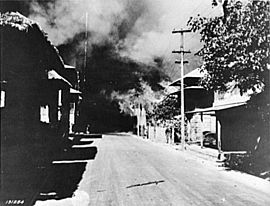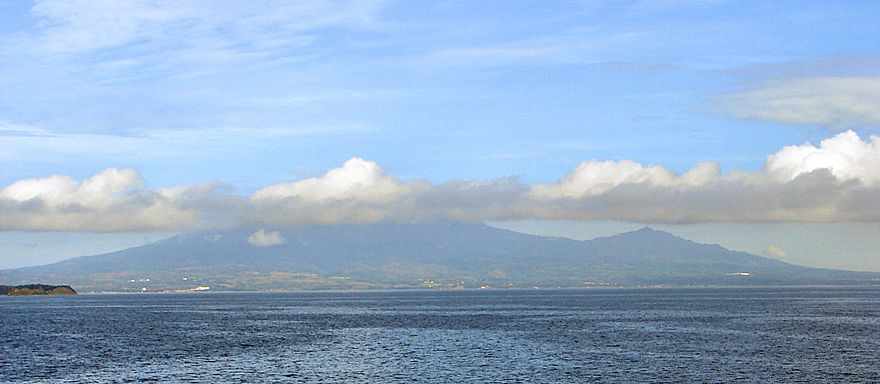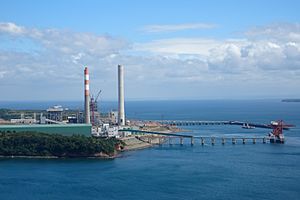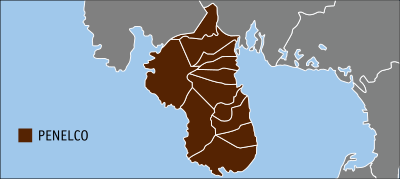Bataan facts for kids
Quick facts for kids
Province of Bataan
Lalawigan ning Bataan
Lalawigan ng Bataan
|
|||
|---|---|---|---|
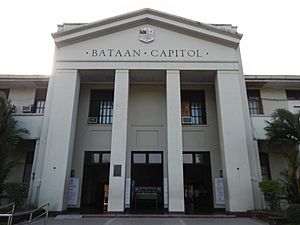 |
|||
|
|||
| Motto(s):
Forward Bataan
|
|||
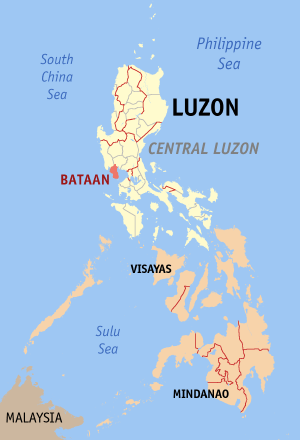
Map of the Philippines with Bataan highlighted
|
|||
| Country | |||
| Region | Central Luzon (Region III) | ||
| Founded | 1754 | ||
| Capital | Balanga City | ||
| Government | |||
| • Type | Province of the Philippines | ||
| Area | |||
| • Total | 1,372.98 km2 (530.11 sq mi) | ||
| Area rank | 72nd out of 80 | ||
| Population
(2015)
|
|||
| • Total | 760,650 | ||
| • Rank | 39th out of 81 | ||
| • Density | 554.014/km2 (1,434.889/sq mi) | ||
| • Density rank | 8th out of 81 | ||
| Divisions | |||
| • Independent cities | 0 | ||
| • Component cities | 1 | ||
| • Municipalities | 11 | ||
| • Barangays | 237 | ||
| • Districts | 1st and 2nd districts of Bataan | ||
| Time zone | UTC+8 (PHT) | ||
| ZIP Code |
2100 - 2114
|
||
| Dialing code | 47 | ||
| Spoken languages | Tagalog, Kapampangan, English | ||
Bataan is a province in the Central Luzon region of the Philippines. Its capital city is Balanga. Bataan is located on the Bataan Peninsula, which is part of Luzon island.
To the north, Bataan borders the provinces of Zambales and Pampanga. The peninsula faces the South China Sea on its west side. To the north-west is Subic Bay, and to the east, it surrounds Manila Bay.
Bataan is famous in history for the Battle of Bataan during World War II. This was a major stand by American and Filipino soldiers. They fought bravely against Japanese forces. The sad Bataan Death March was named after this province. This march began here after the soldiers surrendered.
Contents
Discovering Bataan's Past
Early Settlers and Communities
The first people to live on the Bataan peninsula were the Ayta Magbeken. They are one of the earliest Negrito groups in the Philippines. Later, Tagalog communities from southern Luzon moved into parts of Bataan. By the end of the 16th century, the Ayta Magbeken people had moved more towards the mountain areas.
Colonial Times
In 1647, Dutch naval forces arrived in the Philippines. They tried to take the islands from Spain. During this time, the Dutch attacked the people of Abucay in Bataan.
Historian Cornelio Bascara notes that the province of Bataan was officially created on January 11, 1757. It was formed by Governor-General Pedro Manuel Arandia. He used land from Pampanga and the area of Mariveles. At that time, Mariveles also included Maragondon, Cavite, which is across Manila Bay.
Bataan in World War II
Bataan played a very important role during World War II. Before the Japanese invasion in 1941, Bataan was a military zone. It was used to defend the fortress island of Corregidor. The US Army stored a lot of gasoline and weapons there. At the southern tip of the peninsula, the U.S. Navy had a small base at Mariveles port.
In December 1941, the Japanese Army invaded the country. The combined US and Filipino forces were slowly being defeated. General Douglas MacArthur moved his troops to the Bataan Peninsula. He hoped to hold out there until help could arrive from the US.
Japanese forces began a siege of the peninsula on January 7, 1942. They launched a big attack on April 3. Many tough battles had already happened before this. The Bataan campaign was the last time a regular cavalry unit of the U.S. Army, the Philippine Scouts 26th Cavalry, fought on horseback. On January 16, 1942, Lt. Edwin Ramsey led the last cavalry charge. They rode into the town of Moron and pushed back the Japanese soldiers. Sadly, as food ran out for the troops in Bataan, the horses were eventually used to feed the starving soldiers.
Most American and Filipino forces surrendered on April 9. They were forced to march over 100 kilometers (62 mi) from Bataan to Capas, Tarlac. This terrible event became known as the Bataan Death March.
Bataan's Natural Beauty
Bataan province covers an area of 1,372.98 square kilometres (530.11 sq mi). It takes up the entire Bataan Peninsula. This peninsula is a rocky part of the Zambales Mountains. It extends into the South China Sea and surrounds Manila Bay.
In the northern part of the peninsula is Mount Natib, which is 1,253 metres (4,111 ft) high. It has surrounding mountains. These are separated from Mount Samat and the Mariveles Mountains in the south by a pass.
The eastern side of the province has a narrow coastline plain. The western coast has many ridges, cliffs, and headlands.
People of Bataan
The population of Bataan in 2015 was 760,650 people. This means there were about 550 people per square kilometer.
Ethnic Groups
The three main ethnic groups in Bataan are the Tagalogs, the Kapampangans, and the Ayta Magbeken. The Ayta Magbeken group has a smaller population, even though they were the first inhabitants. The Kapampangans mainly live in the northeast of the province. They are also found in the provincial capital, but in smaller numbers.
Religions in Bataan
People in Bataan follow different religious groups. However, Roman Catholicism is the most common religion. About 85.46% of Bataan's population are Roman Catholics. Other Christian and non-Christian faiths include Iglesia Ni Cristo (4.47%), Evangelicals (2.06%), Aglipayans (1.60%), and other groups.
Learning in Bataan
Universities and Colleges
- AMA Computer Learning Center – Balanga
- APG International Aviation Academy – Cubi Point, Subic Bay Freeport Zone, Morong
- Asia Pacific College of Advanced Studies (APCAS) – Balanga
- Bataan Heroes College – Balanga
- Bataan Maritime Institute – Balanga
- Bataan Peninsula State University – Abucay, Balanga, Dinalupihan, Orani
- Colegio de San Juan de Letran (branch campus) – Abucay
- College of Subic Montessori – Dinalupihan
- Eastwoods College of Science and Technology – Dinalupihan
- EastWoods Professional College of Science and Technology (formerly SOFTNET College of Science and Technology) – Balanga
- Fist Aviation Academy, Inc. – Cubi Point, Subic Bay Freeport Zone, Morong
- Limay Polytechnic College – Limay
- Manuel L. Quezon University – Balanga (under construction)
- Maritime Academy of Asia and the Pacific – Mariveles
- Microcity College of Business and Technology (Formerly: Microcity Computer College Foundation, Inc.) – Balanga
- Omni Aviation School – Cubi Point, Subic Bay Freeport Zone, Morong
- Philippine Women's University – CDCEC Bataan
- Polytechnic University of the Philippines – Mariveles
- St. Joseph College's of Balanga – Balanga
- Softnet Information Technology Center – Mariveles
- Thy Word International Bible College Extension – Mariveles
- Tomas del Rosario College – Balanga
- Tomas Pinpin Memorial Elementary School – Abucay
- TWI, Bethel Bible College Extension – Balanga
- University of Nueva Caceres – Dinalupihan
Fun Places to Visit in Bataan
Historical Sites
- Bataan Death March Marker (Orani)
- Bataan First Line of Defense (Layac, Dinalupihan)
- Filipino-Japanese Friendship Tower (Bagac)
- Limbagang Pinpin (Abucay)
- Mount Samat – Shrine of Valor (Pilar)
- World War II Museum (Balanga)
- Zero Kilometer Death March Marker (Mariveles and Bagac)
- The Flaming Sword (Pilar)
- Cayetano Arellano Monument and Hometown Marker (Orion)
Churches to See
- Nuestra Señora del Pilar Church – Morong
- Nuestra Señora del Pilar Church – Pilar
- Nuestra Señora, Virgen Milagrosa del Rosario Church – in Orani, this church was given the special title of Minor Basilica by Pope Francis in 2019. It holds the amazing image of the Our Lady of Orani.
- San Francisco de Asis Church – Limay
- Diocesan Shrine and Cathedral-Parish of Saint Joseph – Balanga City, this is a special church and the main church for the Diocese of Balanga.
- San Juan Bautista Church – Dinalupihan
- San Miguel Arcangel Church – Orion
- San Nicolas de Tolentino Church – Mariveles
- San Pedro Martir de Verona Church – Hermosa
- Santa Catalina de Alexandria Church – Bagac
- Santa Catalina de Siena Church – Samal
- Santo Domingo de Guzman Church – Abucay, this is the oldest church in Bataan, built in 1587.
Other Interesting Places
- Bataan Tourism Center – Balanga
- Las Casas Filipinas de Acuzar – Bagac
- Philippine Refugee Processing Center – Morong
- Ocean Adventure – Mabayo, Morong (SBFZ)
- Zoobic Safari – Mabayo, Morong (SBFZ)
- Major General Edward P. King (Grave) – Lamao
- Sinagtala Farm Resort & Adventure Park – Orani
- Vista Tala Resort & Recreational Park – Orani
- Camaya Coast (Camaya Sands Resorts and Leisure) – Mariveles
- Montemar Beach Club – Bagac
- Duhat Bike Trail – Orion
- GICC Technopark - Freeport Area of Bataan
- Pawikan Conservation Center - Morong
Natural Wonders
- Ambon-ambon (Lumutan) Falls (Binukawan, Bagac)
- Anvaya Cove (Morong)
- Balong Anito (Mariveles)
- Bataan National Park
- Camaya Coast (Mariveles)
- Dunsulan Falls(Pilar)
- Duhat Trail (Orion)
- Laki (Laque) Beach (Mariveles)
- Marilag Cove (Bagac)
- Mariveles Five Fingers (Mariveles)
- Mount Malasimbu (Dinalupihan)
- Mount Mariveles
- Mount Natib (Orani)
- Nagbintana Arc (Mariveles)
- Panoypoy Cove (Mariveles)
- Pasukulan Falls (Abucay)
- Playa La Caleta (Morong)
- Roosevelt Protected Landscape
- San Miguel Mountain Peak (Mariveles)
- Sibul Spring (Abucay)
- Sinagtala & Vista Tala (Orani)
- Talain Cove (Mariveles)
- Tarak Ridge (Mariveles)
- Tortugas Bay Park (Balanga)
Bataan's Infrastructure
Power Supply
Generating Electricity
Bataan is a big producer of electricity. Most of the power generated here goes to the Luzon Grid. Many power plants in Bataan use fossil fuels like oil and coal. However, some also use renewable energy sources, mainly solar power. The total power from existing plants is 2068.1 MW. New power plants will increase this to 4224.1 MW.
Plants using fossil fuels produce 2020 MW. These are mostly in Limay and Mariveles. Examples include the GN Power Mariveles Coal Power Plant (660 MW) and the Panasia Bataan Combined Cycle Power Plant (620 MW). Two new plants are being built. They will add another 1936 MW.
Renewable energy, mostly solar power, produces 48.1 MW. These plants are in the northern part of the province. Existing solar plants include YH Green Energy Solar Power Plant (12.6 MW) and Citicore Solar Power Plant (18 MW). Three new projects will add 220 MW more.
The Bataan Nuclear Power Plant in Morong was designed to produce 600 MW. It was supposed to be the first nuclear power plant in the Philippines. It was meant to start in 1986. But it was stopped due to concerns about nuclear power. There is talk about either fixing the old plant or building a new one.
Distributing Electricity
Electricity in Bataan is mostly distributed by the Peninsula Electric Cooperative (PENELCO). Some large users get their power directly from the main transmission grid. This grid is run by the National Grid Corporation of the Philippines (NGCP). Their 69,000-volt lines supply PENELCO's substations. In the Freeport Area of Bataan (FAB) and certain villages, power is supplied by the National Transmission Corporation (TransCo) – FAB branch.
Ports and Terminals
- Mariveles Grain Terminal – Freeport Area of Bataan, Mariveles
- Seasia-Nectar Mariveles Dry Bulk Terminal – Freeport Area of Bataan, Mariveles
- Port of Lucanin – Mariveles
- Port of Lamao – Limay
- Port Capinpin – Orion
- Subic Bay International Container Port – Cubi Point, Subic Bay Freeport Zone, Morong
Since late 2017, ferry services have restarted. You can take a ferry from Mall of Asia in Pasay City to Port Capinpin in Orion. A land trip usually takes two and a half hours. But the ferry trip takes only one hour. Shuttles are available at Orion to take passengers to Balanga or Mariveles.
Airport
- Subic Bay International Airport – Cubi Point, Subic Bay Freeport Zone, Morong
Roads and Highways
Bataan has a network of national highways and one expressway. The Roman Superhighway (N301) and Jose Abad Santos Avenue (N3) are key national highways. The Subic–Clark–Tarlac Expressway is a toll road. It connects Bataan with Pampanga and Tarlac. Other roads like Bataan/Old National Road and Governor J.J. Linao National Road connect smaller towns to the main highway system.
Famous People from Bataan
- Cayetano Arellano (Orion) – The first Chief Justice of the Supreme Court of the Philippines.
- Francisco Baltazar (Orion) – A great Filipino writer. He was born in Bulacan but lived much of his adult life in Orion, Bataan.
- Luz Banzon (Balanga) – The wife of Philippine President Ramon Magsaysay. She was the seventh First Lady of the Philippines.
- David Consunji (Samal) – Chairman of DMCI Holdings, a big company.
- Gary David (Dinalupihan) – A basketball player and TV actor.
- Romi Garduce (Balanga) – A mountain climber who reached the top of Mount Everest.
- Merceditas Gutierrez (Samal) – The first woman to lead the Ombudsman's office.
- Norberto B. Gonzales (Balanga) — A former Secretary of National Defense.
- Manuel C. Herrera (Pilar) – An Ombudsman and justice of the Court of Appeals.
- Rodel Naval (Orion) – A Filipino singer, songwriter, and actor.
- Evangeline Pascual (Orani) – An actress and First Runner-up in Miss World 1973.
- Felicito Payumo (Dinalupihan) – Chairman of the Subic Bay Metropolitan Authority from 1998 to 2004.
- Ding Roman (Balanga) – Provincial Governor from 1986 to 2004.
- Tomas Pinpin (Abucay) – The first Filipino printer and publisher.
- Kerby Raymundo (Orion) – A basketball player.
- Geraldine Roman (Orani) – A journalist and politician. She is the first transgender woman elected to the Congress of the Philippines.
- Tomas del Rosario (Orani) – A judge and statesman. He was the first governor of Bataan province from 1903 to 1905.
- Mel Tiangco (Pilar) – A popular TV newscaster and host. She heads the GMA Kapuso foundation.
- Pedro Tuazon (Balanga) – Solicitor General of the Philippines in 1921.
- Janine Tugonon (Orion) – A model and TV host. She was Miss Universe 2012 first runner-up.
- Manuel Bamba Villar Jr. (Orani) – A Senator of the Republic of the Philippines.
- Oscar V. Cruz (Balanga) – Archbishop Emeritus of the Roman Catholic Archdiocese of Lingayen-Dagupan.
- Florita Rubiano-Villar (Samal) – Undersecretary for the Department of Social Welfare and Development.
- Alfredo Juinio (Limay) – Secretary of the Department of Public Works and Highways.
- Manuel C. Sobreviñas (Dinalupihan) - Bishop Emeritus of the Roman Catholic Diocese of Imus.
Images for kids
See also
 In Spanish: Bataán para niños
In Spanish: Bataán para niños




